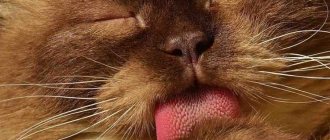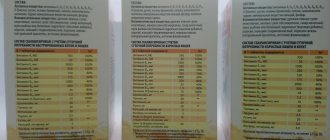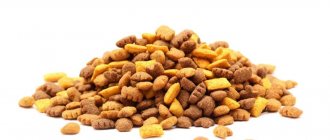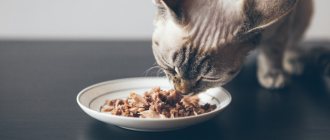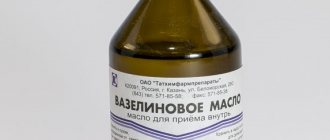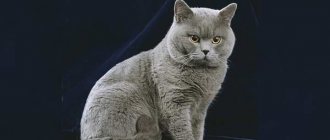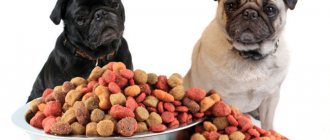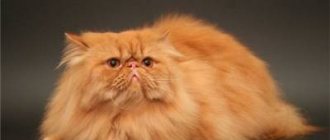The dangers of hairballs in the stomach
Due to the peculiarities of the anatomical structure of the tongue (it is covered with small sharp papillae directed into the larynx), the cat cannot spit out dead guard hairs, so the hair inevitably ends up in the stomach. Due to the inability to be digested by gastric juice, it forms dense balls (trichobezoars) and clogs the gastrointestinal tract. Veterinarians call this phenomenon “gastric trichobezoar.” If not treated promptly, it can lead to the following complications:
- anorexia due to a false feeling of satiety;
- obstruction of the small intestine;
- constipation;
- disruption of the digestive process;
- pain in the gastrointestinal tract;
- ingrowth of villi into the mucous tissues of the oral cavity;
- inflammatory processes.
Due to the presence of trichobezoars in the stomach, the cat experiences constant discomfort. She will independently try to free herself from the foreign body by vomiting, but due to severe blockage, only liquid will come out. If you do not help your pet in time, surgical intervention is inevitable.
It is noteworthy that indoor cats do not have problems with the formation of trichobezoars in the stomach, since they lead an active lifestyle and have the opportunity to eat fresh grass, which improves the transit of fur through the gastrointestinal tract.
Gastric trichobezoars are most susceptible to:
- long-haired cats (Maine Coon, Persian, Siberian, etc.);
- older cats;
- animals that are obese or lead a sedentary lifestyle;
- cats with any type of coat (with the exception of hairless sphinxes, bambinos, elves, etc.) during the molting period.
Long-haired cats are most susceptible to gastric trichobezoar.
Personally, for the purpose of prevention, I always give my cat special homemade grass (it is sold in pet stores). It is a natural remedy for cleansing, contains minerals, amino acids, B vitamins, which not only improve digestion, but also have a beneficial effect on the appearance of the pet.
Wheat germ is the best remedy for preventing the formation of hairballs
Basic Rules for Preventing Hair Buildup
To prevent fur from accumulating in your pet’s body and causing problems, you must follow a number of rules regarding food management:
- feeding should be balanced - this will avoid increased hair loss;
- when feeding natural food, do not forget about the sources of fiber - the cat’s diet must contain vegetables and herbs, in particular beets, lettuce, parsley, pumpkin, zucchini, carrots, etc.;
- the cat must have constant and unlimited access to clean water - a lack of fluid has a bad effect on the functioning of the gastrointestinal tract and makes it difficult to defecate in general, not to mention the productive output of fur;
The cat should receive clean water in unlimited quantities.
- cats on a dry diet should receive food constantly or periodically to facilitate the process of moving hair through the gastrointestinal tract;
- It is necessary to provide the animal with access to fresh grass. It is not necessary to let the cat outside; it will be enough to grow a small garden bed for it right in a pot on the windowsill.
Our family has had a furry pet for 16 years now—the Persian extreme cat Katrina. We know firsthand about the problem of fur - in its best years, the pet looked like a huge ball of fur with a tail. Out of ignorance, at first they weren’t worried about shedding hair, but when episodes of regurgitation became very frequent (almost daily), they went to the doctor. On the advice of the veterinarian, we planted grass on the windowsill for Katrina and bought a special paste.
In addition to nutrition, caring for the coat itself is of great importance. Be sure to comb your pet regularly to help remove lost hairs, and special attention should be paid to this procedure during shedding. For example, Persians sometimes have to be thoroughly combed 2-3 times a day in the off-season.
When should you give your cat hair-removing food?
The following symptoms indicate the presence of hairballs in your pet's stomach at an early stage:
- anxiety, nervous excitement;
- mucus in undigested food or stool;
- nausea, vomiting;
- constipation or diarrhea;
- dry cough;
- the coat becomes oily and dull.
In the case of severe blockage of the gastrointestinal tract, the cat experiences frequent vomiting (without hair, but with blood), a complete absence of stool for a long time (despite the animal’s unsuccessful attempts to relieve itself), as well as refusal to eat. At the same time, it cannot be said that the pet has no appetite: on the contrary, he begs for food, but cannot handle even the minimum portion. This is due to the fact that the cat does not receive the required amount of nutrients due to a feeling of false satiety. If such symptoms are present, the owner must urgently begin treatment.
Rules of use
Special food for hair removal is enriched with essential vitamins and minerals, has the correct BJU ratio, and is therefore complete. If symptoms occur that indicate the presence of trichobezoars in the stomach, the cat must be completely switched to “medicinal” food and fed until the problem disappears.
Before use, be sure to read the information on the packaging: the manufacturer gives clear instructions and recommendations. The average daily intake is 15–20 grams per 1 kg of animal weight. If desired, the portion can be increased (the cat can eat as much as it is used to). Usually the course lasts about a month. The first positive changes are observed within the first week. For preventive purposes, food can be given 1-2 times a month.
My cat, although he ate store-bought canned cat food, flatly refused special food. It was possible to remove the hairballs with the help of a cleansing paste, which he absorbed with particular pleasure. Each pet's tastes are individual, so the owner will have to find a suitable remedy through trial and error. If the cat refuses to eat one food, I recommend trying to purchase 1-2 more products from different manufacturers. Surely there will be food from them that the fluffy will like.
Rules for breeding wool
The cat's fur is falling out: why and what to do
Before removing fur from a cat’s stomach at home, you should familiarize yourself with the main rules of the procedure.
- At the initial stages, you can try to remove hair from the stomach using traditional methods, for example, using green grass. After eating it, the cat will vomit and the foreign body will be expelled from the body.
- In advanced cases, special foods and medications are used. In parallel with therapy, you need to monitor the cat’s food and drink. Proper nutrition and plenty of fluids will help the wool clots leave the stomach quickly;
- For long-term constipation and intestinal obstruction, use Vaseline oil orally. It helps to relieve the animal's condition and soften the feces.
If home treatments do not help remove hair, you should urgently make an appointment with a veterinarian.
Product composition
Hair removers contain several types of insoluble fiber that soften lumps and accelerate their transit through the gastrointestinal tract. Natural plant components (plantain seeds, flax) and oils envelop the walls of the stomach (serve as something like a lubricant), which allows trichobezoars to freely leave the pet’s body. The presence of vitamins and minerals helps normalize digestion and has a beneficial effect on the quality of the coat: it becomes shiny, smooth, and does not shed as much.
Hair-reducing food is suitable for animals that mainly eat ready-made store-bought products (canned food for cats, dry and wet food, etc.). Such cats practically do not feel the difference between new and old food, and therefore calmly accept “medicinal” food. This option is not suitable for pets whose diet consists of natural products. To remove hair, it is recommended to give them special cleaning pastes (Beafar, Cliny, Gimpet Malt-Soft Extra, Beafar). The principle of action and composition of such products are similar to hair removal feeds.
What food will help your pet?
Since it is impossible to remove fur from a cat’s stomach on their own, the only thing left for a caring owner is to facilitate this process. For therapeutic and prophylactic purposes, special dry and wet food is widely used. The main ingredient in this diet is malt - this is a popular and effective component that is involved in softening trichobezoars and helping to remove them naturally. Such food is enriched with fiber, minerals and vitamin complexes, which has a beneficial effect not only on the functioning of the digestive system, but also on the condition of the pet’s coat.
Royal Canin Hairball Care
A French brand known for its good reputation. Hair breeding food is suitable for all breeds and ages. In addition to animal proteins, fats and vitamins, it contains cereals, beet pulp, as well as flax and plantain seeds. Fiber and specific additives improve intestinal motility and stimulate the excretion of swallowed wool.
Purina Cat Chow Special Care Hairball Control
These products are designed for cats with a low level of activity, namely those living exclusively at home. In addition to standard ingredients that help get rid of hairballs in the stomach, it contains poultry, tuna and liver, as well as essential Omega amino acids. As a bonus, the form of granules allows you not only to prevent the formation of tartar, but also to cleanse the oral cavity of stuck hairs.
Savarra Adult Cat Hairball Control
Dry food originally from the UK belongs to the holistic class products. This means that its manufacturers used a balanced formula based on the most natural ingredients possible. It is hypoallergenic and rich in antioxidants. Suitable for adult pets from one to seven years old.
Monge Cat Hairball
Provides purrs with satiety due to the high meat content. At the same time, Monge contains L-carnitine, which helps accelerate the animal’s metabolism, as well as a complex of minerals and vitamins A, B, C, D, E.
Hill's Science Plan Feline Adult Hairball Control
Products of European quality have an excellent preventive effect and are suitable for daily use. The recipe includes the nutrients necessary to strengthen the coat and minimize hair loss. The food is intended for mature cats.
Eukanuba Adult Dry Cat Food Hairball Control
In addition to helping to remove trichobezoars, it has a positive effect on the animal’s coat. This is facilitated by selenium, iodine and brewer's yeast, which the manufacturer introduced into the diet.
Is it dangerous
When it enters the stomach, fluff accumulates, forming lumps that disrupt the digestion process. And these are not all the problems that the pet faces.
Clogging of the gastrointestinal tract
Once inside, the hard hairs are compacted, forming hair follicles.
Such formations are not digested in the stomach and are not excreted naturally, clogging the intestines.
Changing eating behavior
Hairs accumulated in the stomach give a false feeling of fullness. The animal may feel hungry, but when it approaches the bowl, it cannot eat even a piece of what is offered. A voluminous lump occupies the entire stomach cavity, giving a feeling of satiety.
Intestinal blockage
Over the course of life, fur gradually accumulates in the stomach, blocking its passage. This condition is life-threatening for the pet.
A serious blockage can only be removed through surgery.
Dental problems
Individual villi accumulate behind the cat's teeth, growing into the gums. This leads to the development of inflammatory processes in the oral cavity.
Vitamin therapy
As an addition to the main diet, the veterinarian may prescribe a vitamin and mineral complex.
It is in this series that the best vitamins for cats against hair loss are found:
- Derm Caps Derm Liquid (metabolism is restored, hair follicles are strengthened);
- Canina Cat-Fell OK (the fur stops falling out in clumps);
- Gimpet Katzentabs (the animal receives all the necessary substances for health);
- Laveta Super For Cats (the fur becomes shiny and fluffy);
- Cat Felltop Gel (health improves);
- Felvit (immunity increases);
- In-Up (the coat becomes beautiful and silky).
Any of these complexes contains all the necessary substances for cats. Typically, one course is one month.
Photo vitamin for cats against hair loss
Read here Purina Van for cats - 140 photos of food, their composition and features of use in the diet
Help the site, share with friends 
2
What is the “salt”?
Absolutely all cats love to lick themselves. During this process, a certain amount of fur enters their stomach. If the lint does not come out naturally, it clumps into large, hard clumps and can cause serious health consequences. This problem is especially relevant for long-haired cats - after all, they have more villi, which means a lot of them get into the stomach.
Wild cats “solve” this problem very simply. They eat all kinds of grass and other vegetation rich in coarse fibers. They promote gentle removal of fur from the gastrointestinal tract along with feces.
The lint does not accumulate and does not form lumps. Domestic cats, who often only see grass on TV, are less fortunate. The owner should take care of the fiber in their diet, making the long-haired pet’s diet as healthy as possible.
There is one more point. In order for the coat of long-haired cats to have a healthy and beautiful appearance, the animal’s body needs vitamins and useful minerals. It is very good if they are present in the food. Otherwise, the hair will look dull, faded, begin to tangle, or even fall out altogether.
Reviews, vitamins for cats against hair loss
Valentina, Kirov:
“Sherstevit” did not help our Murochka. The fur was coming out in clumps. But “Laveta Super For Cats” began to help from the first week. Now we buy only this complex.
Felix food for cats: reviews, composition overview, use in the diet, price and food combinations (125 photos)What to feed a sterilized cat: video tips on how to properly, what and when to feed a cat after sterilization (125 photos + video)
Wellness for cats - choice of food, analysis of composition, reviews and overview of the most popular types (100 photos)
Evdokia, St. Petersburg:
My Vaska was itching all the time, to the point of wounds. And the fur was shedding and was dull, not shiny. After using In-Up, the situation improved. Now he is healthy.
Egor, Perm:
Our Marquis had a receding hairline. After a course of treatment with the Farmavit Neo complex, the hair began to grow less. We also look at nutrition.

